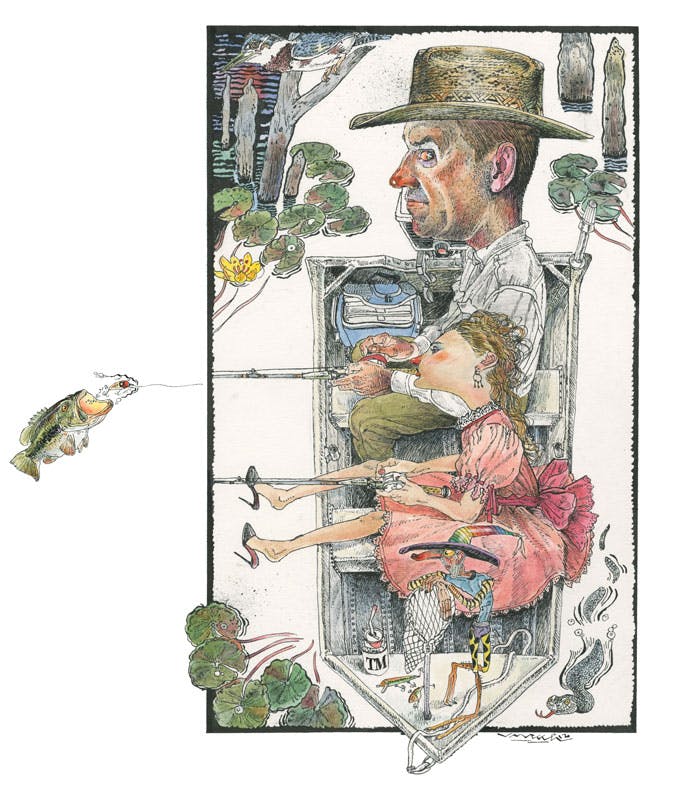
Q: My twelve-year-old daughter is a complete and unashamed tomboy. She hunts with me, fishes with me, and throws the football with me. Wouldn’t be caught dead in a dress. I love every second of it, but her mother thinks it’s come time for her to drop some of these boyish pursuits and start acting and dressing more like a “lady.” I hate to lose my little pardner, but is the girl’s mom right? Could all these manly endeavors leave a permanent mark as she develops into womanhood?
Name Withheld
A: The Texanist comes from a long line of hardy Texas women. He also married a hardy Texas woman and, in time, begot a small Texas woman just as hardy as the one you have described. Football? Check. Fishing? Check. Dirty fingernails, perpetually scabby knees, good horsemanship? Check. Handy with a bow and arrow, unflappable in the face of weird bugs, vehemently opposed to skirts? Checks all around. Needless to say, this sweet little hellion is the apple (sometimes the crab apple) of the Texanist’s eye and a shining example of the trademark sturdiness for which Texas women are known all over the world. Where does it come from? As determined by a pseudoscientific study commissioned long ago by the Texanist, there is simply something in the water (subsequent attempts, however, to bottle and sell this clear elixir across state lines were unsuccessful). Not only is your daughter’s tomboyishness nothing for you or her mother to fret over, it is her birthright. That joie de vivre, effervescence, bumptiousness, and even, please pardon the Texanist, ballsiness that you’ve come to love in her are merely the traits of a full-grown Texas woman in the making. Besides, the peer pressure, social mores, and discovery of boys that come with adolescence will soon serve to smooth out the rougher edges. This is when the Texanist would advise you to commence the real worrying.
Q: My wife and I recently repatriated to Texas after 45 years in Marin County, California. We are surprised at how much food comes out of restaurant kitchens at four- to five-alarm spicy hot. We’re both two-alarm people with a three-alarm threshold. A navy bean soup with unannounced jalapeños—is that necessary? I believe that if the good Lord intended for every dish to come from a chef spicy hot, he or she would not have created Tabasco sauce. We’ve visited Texas often over the past 45 years and have only noticed this predilection in recent times. Have you noticed this fiery trend?
Prince Altom, Wimberley
A: Welcome home. You know, thinking back on the past 45 years, the Texanist supposes that there very well could have been a slight ratcheting up of the average number of Scoville heat units per plate, but he’s noticed nothing drastic of late. The problem seems to be with your own spiciness alert systems. You say that you and your spouse are both two-alarm folks with a maximum peak of three alarms and that you are native Texans. This is interesting, as the average Texan is born with a comfortable low end of two and a half alarms and, over time, will see that level increase to four, five, five and a half, even all the way to six or seven alarms. The Texanist suspects that your California sojourn has caused a degree or two of what is known to the Texas hot sauce set as West Coast Decline. Don’t sweat it. Now that you are repatriated, a full taste bud re-acclimation shouldn’t be too far off.
Q: I am a recent graduate of the University of Texas at Austin and a hard-core Horns fan. Needless to say, I am anti-Aggie. And as such, I have always shied away from maroon clothing. Now that the rivalry has come to an end, do you think it would be okay to introduce a maroon piece into my wardrobe?
Sherry Balderrama, San Antonio
A: Sure, go ahead and buy yourself a maroon blouse. Why not? In fact, fill your closet with them. Who cares anymore? Why even have Thanksgiving? What’s the point??? [Editors’ note: The demise of this rivalry remains a sore subject for the Texanist and has rendered him unable to provide fine advice on this or other related matters; please ask him about something else.]
Q: After a recent fishing trip with some buddies down in Rockport, I have been bothered by something that occurred. We hired a pricey guide, and while he earned his fee, quickly putting us onto some fish and limiting us out before lunch, we all saw him fudge some redfish measurements. As you know, redfish have to be between 20 and 28 inches long to keep without the proper tag. That night, as we sat around the dinner table (yes, we had redfish), we wondered if he was being careless or if the length requirements are a figure that can be ballparked. We also wondered what the penalty would have been had we been found out.
Name Withheld
A: Ever since that critical point in the long and winding course of human history when fishing evolved from an exercise in survival to a means of whiling away half the day with a line in the water and a beer in the koozie, man has been inclined to fudge the numbers. There is a humongous difference, however, between the honorable tradition of grossly exaggerating one’s own angling exploits for the purposes of self-aggrandizement and the sort of trickery perpetrated by your guide. This man, licensed by the State of Texas, appears to have drifted into the dangerous waters of corner-cutting. Haphazard fish measurement aimed at evading the official rules is no joke. The Texanist is not laughing and doubts that the local game warden is either. The reality is that taking redfish that ought not be taken could land you an 1120 (undersized fish) or 1121 (oversized fish) citation. And that would be nothing to brag about.








